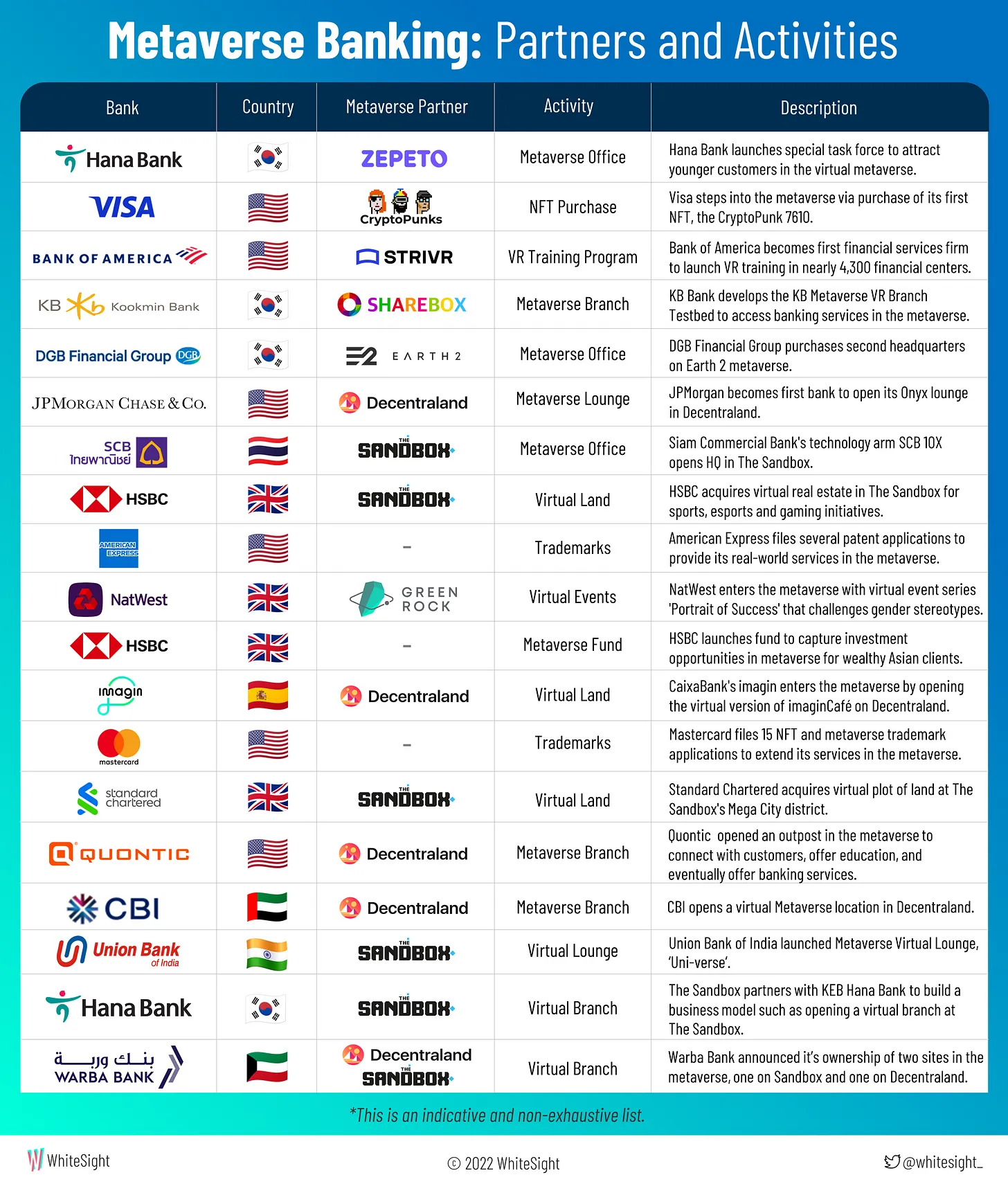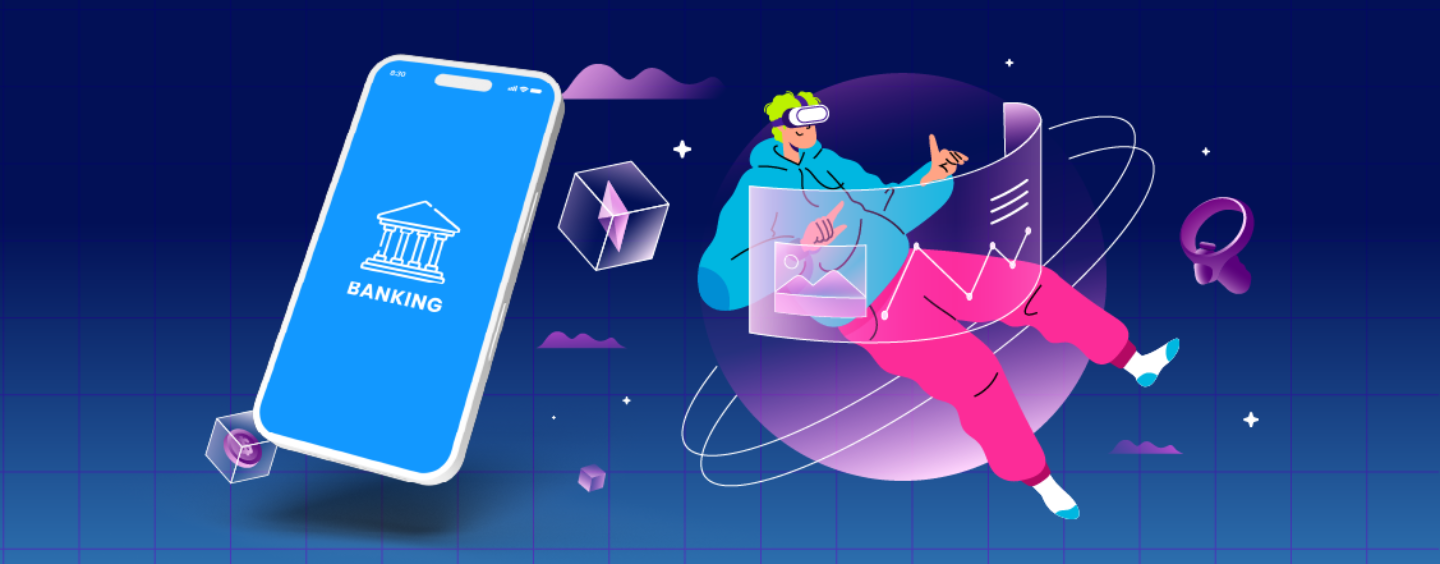Banks from around the world are actively exploring the opportunities brought about the metaverse, purchasing virtual land and establishing presence on popular platforms. They believe these virtual environments will help them better engage with younger customers, collaborate with partners and train staff, a new analysis by fintech-focused research firm WhiteSight shows.
The analysis, released on August 25, 2022, delves into the major moves that have made by banking incumbents and financial institutions, outlining the different ways they’ve engaged in the metaverse, including land acquisition, trademark and patent filings, and more.
First, many banks are purchasing plots and virtual real estate on popular platforms like The Sandbox and Decentraland, the report notes, a move that’s generally intended to enabling them to establish a presence.
JPMorgan was an early mover, launching in February 2022 its Onyx Lounge in Decentraland. This was followed later on by HSBC, which acquired in March a plot of virtual real estate in The Sandbox to engage with sports, e-sports and gaming fans. Standard Chartered was next, buying virtual land in The Sandbox as well in April to engage with “clients, partners, staff, and the tech community, to explore co-creation opportunities.”
Industry stakeholders are also actively filling for intellectual property (IP) protection, the report says, citing the example of Mastercard, which filed 15 non-fungible token (NFT) and metaverse trademark applications in April 2022 to broaden its payment processing system into the new virtual economy.
Similarly, filings suggest that American Express is seeking to have its real-world payment services work in the metaverse. Trademarks filed indicate that the company is considering providing card payments, ATM services, banking services, and fraud detection to customers in virtual environments.
Bank training and skill development programs are also starting to take shape in the virtual world, the report notes. In South Korea, Hana Bank launched last year a virtual training center on Zepeto, an avatar app operated by the country’s largest Internet company Naver. Bank of America introduced in October 2021 a new virtual reality (VR) training program, allowing approximately 50,000 employees to practice a range of routine to complex tasks and simulate client interactions through a virtual environment.

Metaverse banking: partners and activities, Source: WhiteSight, 2022
Reaching younger demographics and enabling new business models
The metaverse, a concept referring to a shared virtual environment that people access via the Internet, has become one of the hottest business trends of the past two years.
In H1 2022, companies, venture capital, and private equity firms invested more than US$120 billion in the metaverse, according to McKinsey and Company. The sum is more than double the US$57 billion invested in all of 2021, showcasing investors’ continued bullishness in the prospect of the sector.
The consultancy estimates that the metaverse could grow up to US$5 trillion in value by 2030 in value, with e-commerce emerging as the largest economic force (US$2.6 trillion), ahead of sectors such as virtual learning (US$270 billion), advertising (US$206 billion), and gaming (US$125 billion).
For banks, the metaverse represents a huge opportunity to attract young or new customers, enhance customer journeys and create new products, says Chappuis Halder, a management consulting firm part of Capgemini Invent.
One exciting business model enabled by the metaverse is play-to-earn. With play-to-earn, players can recoup in-game earnings as real-world cash, or transfer them to other games, players, or platforms, through cryptocurrencies. This essentially means that players can use their in-game items to buy, sell, and trade digital assets globally, creating thus brand new financial ecosystems, the firm says.
In this scenario, banks could support marketplaces in the creation, ownership and exchange of digital assets, as well as connecting these marketplaces to the traditional economy and fiat currencies, it says.
Health-to-earn is another promising area. These games typically combine play-to-earn, NFTs and GPS technology to track users’ movements and health activities. Data are stored on a blockchain and converted into rewards, typically in the form of cryptocurrency. These rewards are earned by completing in-game tasks like finishing a workout, walking, cycling, running, and so on.
Financial institutions could make use of health-to-earn, allowing, for example, their employees to play fitness games in the metaverse, get rewarded with crypto tokens and accumulate crypto earnings for their medical reimbursement accounts (MRAs). For insurance companies, they could develop specific offers that reward healthy behavior, using gamification to promote better coverage, premiums and health, Chappuis Halder says.
Featured image credit: freepik






